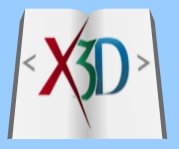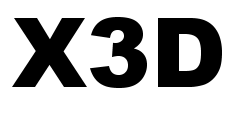Mouse-over the figure to see a larger version. Please allow a little time for the larger image to download.
Click on any of the figures to view a large version in a separate window.

Figure 8.1. This example shows two TouchSensors, the door on the left is activated on a button-down (isActive true) event. The door on the right is opened on a button-up (touchTime) event.
Figure 8.2. This example (TouchSensor.x3d) shows the pump house, which is activated when the button is pressed down while the cursor is over the pump house.
Figure 8.3. A PlaneSensor is indicated by the red bar. The sensor output controls the amplitude of the pump.- Image Not Available - Figure 08-04
Figure 8.4. Shows how the diskAngle field determines whether a userís drag motion produces a rotation that is either in end-cap disk mode or cylinder-walls rotation mode. 
Figure 8.5. The position of the CylinderSensor is indicated by the red knob and pointer. Rotating the knob changes the userís viewing angle.- Image Not Available - Figure 08-06
Figure 8.6. Setting a CylinderSensorís axis of rotation to be different from sensed geometry is best accomplished by using the design pattern shown in this scene graph. 
Figure 8.7. The orientation NPS shark is manipulated with a SphereSensor on the blue sphere.
Figure 8.8. The KeySensor example allows the user to change the viewpoint.
Figure 8.9. A StringSensor allows the entry of the string "X3D: Extensible 3D Graphics!" into this X3D world.
Portions of this work are from the book,
X3D: 3D Graphics for Web Authors, by
Don Brutzman and Leonard Daly, published by Morgan Kaufmann Publishers,
Copyright 2007 Elsevier, Inc. All rights reserved.
Web site copyright © 2008-2017, Daly Realism and Don Brutzman



